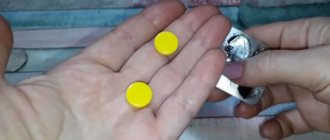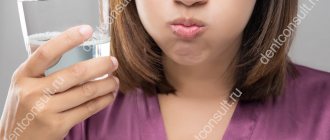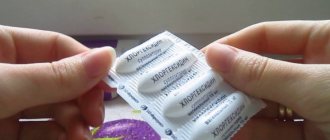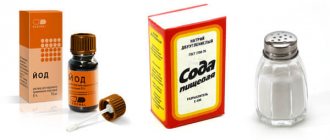One of the most effective methods of treatment for various diseases of the throat and oral cavity is gargling with hydrogen peroxide. Hydrogen peroxide is a clear liquid that more closely resembles water. But in concentrated form it is dangerous for the mucous membranes, so for rinsing it must be diluted.
Oxygen can affect not only bacterial cells, but also the epithelium. Therefore, it is necessary to rinse with the product as carefully as possible.
The action of peroxide is based on the oxidative process carried out by active oxygen. The process affects DNA cells and lipids. As a result, with weak oxidation, the cell is able to recover, and with intense oxidation, it dies.
Using the solution for various diseases
There are a number of diseases for which gargling and rinsing is considered the most effective:
- angina;
- pharyngitis;
- laryngitis;
- stomatitis;
- periodontal disease.
For each disease, it is necessary to select the proportions and duration of treatment.
Tonsillitis and its acute form - sore throat, including purulent one. Sore throat is an infectious disease associated with the inflammatory process in the mucous membrane of the tonsils. Harmful bacteria not only kill normal microflora, but also penetrate into the tissues of the body.
To treat a sore throat, it is recommended to gargle with a solution prepared according to the following recipe:
- in a glass of water you need to dissolve a teaspoon of 3% peroxide;
- You need to pour boiled water into another container;
- First, the solution is treated, and then the throat is rinsed with clean water to remove any remaining medication.
A hot solution sometimes provokes inflammatory processes, and a cold solution is often a factor in the onset of complications. Therefore, gargle only with warm liquid. To obtain the effect, it is necessary to observe the proportions of the solution, since the healing process may be delayed.
Pharyngitis is a disease characterized by inflammation of the pharyngeal mucosa. A hydrogen peroxide solution for gargling can alleviate symptoms.
For pharyngitis, rinsing with liquid has several purposes:
- washing out viruses and bacteria;
- flushing pathogenic mucus from the nasopharynx;
- antiseptic effect on the lesion;
- increasing local immunity;
- acceleration of tissue generation in various forms of the disease.
In case of illness, the procedure should be performed hourly at the beginning of treatment, a little later the number of procedures is reduced to 5 times a day. For chronic pharyngitis, you should gargle twice a day. This frequency is used as a preventive measure.
How to dilute hydrogen peroxide for gargling
To prepare the solution you need to take hydrogen peroxide and boiled water. The water must be boiled. After boiling, it needs to be cooled to a temperature that is comfortable for the throat.
After the water in the glass has cooled, add 1 tablespoon of the drug and mix thoroughly.
Before gargling, you need to rinse it with clean boiled water or a weak infusion of chamomile. You can also take calendula infusion or any other infusion of medicinal plants. This will help prepare the throat mucosa for further procedures.
Rinsing should not last more than 30 seconds. After this, the throat is rinsed with clean boiled water in order to remove any remaining product.
For each rinse, you need to prepare a new solution.
In addition, an important point is the choice of pharmaceutical product. It should be a concentration of no more than 3%.
Treatment of laryngitis
Laryngitis - in some cases of illness, rinsing with peroxide often has a complex effect:
- relieving sore throat;
- eliminating dry throat;
- improving the patient's well-being.
You need to gargle with peroxide 2-3 times a day for a week.
Stomatitis - the effect of peroxide on the affected areas has the following effects:
- antibacterial cleansing;
- elimination of itching and soreness;
- reduction of swelling.
The course of treatment is two weeks, twice a day.
Periodontal disease is associated with the appearance of ulcers in the mouth. A solution of hydrogen peroxide promotes the healing of formed mucosal defects.
Does gargling with hydrogen peroxide help?
The main property of the drug is its antiseptic effect. This means that the product “kills” pathogenic microorganisms in the throat, preventing their further reproduction.
This is a cheap pharmaceutical medicine with high effectiveness. Sometimes simple remedies help us no worse than expensive and promoted ones.
In addition, it has the following therapeutic effects:
- cleansing the mucous membrane of bacteria, viruses or fungi;
- reduction of the inflammatory process;
- anesthesia;
- removal of purulent plugs in the tonsils.
Recommendations on how to gargle correctly.
Before you start gargling, you need to prepare your throat. To do this, you will need a solution of boric acid, prepared in the ratio: a teaspoon per glass of warm water. Then you need to prepare a peroxide solution. To do this, you need to dissolve a tablespoon of the substance in ½ glass of warm boiled water.
After completing the procedure, the inflamed area should be rinsed with another liquid:
- ordinary boiled and heated water;
- soda solution;
- chamomile decoction;
- sage decoction;
- potassium permanganate solution.
How to treat a throat with peroxide according to Neumyvakin
Professor Neumyvakin introduced many methods of drug treatment into practice.
Rinse according to Neumyvakin:
- 1-2 teaspoons of peroxide;
- ¼ cup boiled water.
Everything needs to be mixed and then gargled. During the rinsing process, you need to retain the solution in the tonsil area.
In addition to gargling, Neumyvakin, other methods of treatment were invented. For example, treatment of skin diseases or diseases of the mouth and gums.
Indications for completion of therapy
Typically, the course of additional treatment ends only after improvements are noticeable:
- purulent discharge disappears;
- the mucosal epithelium is restored;
- sore throat is eliminated.
Carrying out the gargling procedure in compliance with the basic rules means getting the maximum effect.
Basic recommendations for gargling with hydrogen peroxide:
- A 0.25% hydrogen peroxide solution is suitable for rinsing.
- The optimal temperature for the procedure is 50–60 degrees.
- You can eat food after rinsing only 30 minutes later.
- The best option for complex treatment is the use of rinses as additional therapy.
When treating with peroxide solution, it is necessary to take into account possible side effects and obvious contraindications to the use of the substance.
Hydrogen peroxide is an affordable aid for oral hygiene.
Hydrogen peroxide is an excellent antiseptic that is often used to treat small wounds.
Due to its versatility and availability, peroxide can be found in almost every home medicine cabinet. Peroxide contains molecules of oxygen - O and hydrogen - H, which determines its oxidizing properties, which allow it to cope with a large number of bacteria. This inexpensive remedy helps protect teeth and gums, as well as prevent the development of colds.
The most common concentration of hydrogen peroxide available in pharmacies is a 3% solution. Higher concentrations are typical for industrial production.
Due to its antibacterial properties, hydrogen peroxide helps in treating gum disease.
Plaque that forms on teeth forms a strong protective film of bacteria called biofilm. Hydrogen peroxide, due to its oxygen content, helps to destroy this defense and destroy plaque.
Recent studies conducted in 2022 have shown the benefits of using hydrogen peroxide as an adjunct non-surgical treatment for periodontitis. Studies have been conducted in which it was proposed, in addition to the standard treatment of periodontitis, to use a peroxide-based drug to treat gums. The results showed that by the end of the study, the hydrogen peroxide group had significantly fewer signs of gum disease, compared to the group that received only the standard treatment.
Hydrogen peroxide keeps teeth white.
In fact, many types of toothpaste and mouthwash already contain this compound.
Unusual studies conducted on bovine teeth stained with tea showed that over time, a liquid containing hydrogen peroxide significantly increased the whiteness of the teeth. Of course, when comparing the speed and depth of whitening, special products show significantly better results, but they, in turn, require a careful approach and control by the dentist to avoid damage to the enamel.
Whitening rinses are contraindicated in cases of thinning enamel and severe tooth damage. Relief of sore throat.
One of the causes of throat diseases is bacterial infections. Gargling with a hydrogen peroxide solution can relieve discomfort by reducing the amount of bacteria in the mouth and helping to quell infection. As already written above, the oxygen contained in the peroxide changes the environment of anaerobic bacteria and prevents their growth.
Hydrogen peroxide combats bad breath.
When rinsing with this solution, foam with a large number of bubbles filled with oxygen is formed. This allows you to effectively clean the most difficult to reach places in the oral cavity, removing dead cells and significantly reducing the number of bacteria. Rinsing ensures the death of microbes that cause an unpleasant odor.
How to use hydrogen peroxide to rinse your mouth and throat. It is important to know how to use hydrogen peroxide solution correctly to get maximum benefits and avoid unwanted side effects.
To gargle with hydrogen peroxide, you must first dilute it with water following the included instructions. As a rule, a 3% solution of hydrogen peroxide is diluted with water in a ratio of 1:11, or according to the doctor's instructions. If you add a few drops of essential oil, such as peppermint, to the resulting solution, this will significantly improve the taste of the rinse.
There is no need to make a more concentrated solution for rinsing, as this can lead to burns of the mucous membrane. Also, to avoid possible gum irritation, limit rinsing to a few times a week.
Avoid swallowing hydrogen peroxide. Although ingesting small amounts of the 3% concentration does not usually cause serious problems, it may cause stomach upset and vomiting.
Children should not gargle with hydrogen peroxide solution if they are likely to swallow it. Adults should always supervise the child's rinsing process.
If irritation develops after gargling and does not go away after a few hours, stop using hydrogen peroxide.
In rare cases, more serious individual side effects may occur.
In any case, if a person prone to allergic reactions needs to consult with his doctor about the use of rinses with hydrogen peroxide.
When visiting a dentist, be sure to inform him that you are using home rinses with a peroxide solution in order to receive recommendations and an assessment of the effectiveness of the rinses from a specialist.
Contraindications and side effects
Rinsing with peroxide is not recommended for pregnant women, children and people with individual intolerance to the substance. Therefore, you need to take into account the recommendations of doctors:
- When used by pregnant and lactating women, care must be taken to ensure that the solution does not enter the stomach.
- It is important to dilute the substance with water in accordance with the proportions.
- The frequency of rinsing should be agreed with your doctor.
- Treatment of children with this remedy is undesirable, as they may swallow liquid that is dangerous to the stomach.
If the dosage is incorrectly selected, pain and heaviness sometimes occur in the gastrointestinal tract. To eliminate symptoms, you need to reduce the number of drops for preparing the product and take a break in treatment for five days.
The use of hydrogen peroxide is not only effective, but also convenient. If necessary, the solution can be easily placed in a bottle and taken with you on the road.
Diseases for which a sore throat can be treated with peroxide
The main diseases for which rinsing with peroxide can be used are acute or chronic diseases of the mouth and throat.
The most basic ones are:
- acute or chronic tonsillitis (tonsillitis);
- ARVI;
- flu;
- stomatitis (inflammation of the oral mucosa);
- injuries and conditions after operations (tonsil removal);
- acute or chronic pharyngitis (inflammation of the back of the throat).
Side effects of peroxide and contraindications for use
The solution is considered the safest drug, which is indicated even during pregnancy. Usually no unpleasant symptoms occur and they occur very rarely, but still. Forewarned is forearmed.
But it also has side effects:
- irritation of the mucous membrane;
- allergic reactions;
- irritation of the mucous membrane of the esophagus or stomach (if accidentally swallowed).
Contraindications for rinsing are:
- children under 3 years of age;
- allergic reactions to the drug.
What to do after rinsing
After gargling, be sure to irrigate your throat with plain boiled water at room temperature or a decoction of medicinal plants. This is necessary to soften the mucous membrane of the pharynx, as well as to remove residual peroxide.
You can use solutions of sea or table salt.
It is also not recommended to refrain from eating and drinking liquids for 1 hour after rinsing.
Use of the product during pregnancy
During pregnancy, it can be used as prescribed by a doctor. Since this drug does not have many side effects and does not have a negative effect on the fetus.
But during pregnancy, rinsing alone is not enough, since a viral or bacterial disease can be dangerous for the child. Therefore, rinsing is often combined with other methods of treatment:
- antibacterial therapy (antibiotics are selected taking into account the woman’s position);
- throat sprays (Miramistin);
- rinsing with a decoction of medicinal plants.
Despite the large number of modern medications, hydrogen peroxide is considered one of the most effective and safe drugs.
The minimal number of side effects makes it the most preferred treatment option for children and pregnant women. In addition, the main advantage is the low price of the drug.
Rinse depending on the disease
Different diseases of the throat and oral cavity have their own characteristics and time frames for treatment.
- Acute tonsillitis (tonsillitis). To rinse, you need to dissolve 1.5 teaspoons in 100 ml of boiled water. Rinsing should be combined with other treatment methods, including antibacterial therapy.
- Chronic tonsillitis. Rinsing is prescribed at the time of exacerbation of the disease or during the season with an increased risk of viral infections (autumn - winter). The throat treatment is carried out 2 times a day for 14 days.
- Acute pharyngitis. Prescribed as an auxiliary treatment of the disease. Rinsing is carried out 3 times a day for 7-14 days. Often combined with other drugs.
It is important to know!
A list of measures that must be followed for general safety.
- If a solution of any concentration gets into the eyes, inflammation or irritation occurs, they should be rinsed with water as much as possible and immediately visit an ophthalmologist.
- The product should be stored out of the reach of children. Once in the stomach, hydrogen peroxide can behave differently and lead to different consequences, including death.
- Always maintain proportion. Using the product undiluted is strictly prohibited.
- When using highly concentrated hydrogen peroxide to rinse your mouth, irritation and burns may occur.
- The water used in the solution must be potable and not contain chlorine.
- Vitamin C is the main companion of the solution in any type of therapy. The greatest effect will be obtained from fruits and vegetables consumed in large quantities during the period of using hydrogen peroxide.
- The product should be stored in a dry place and avoid direct sunlight on the bottle. Otherwise, the peroxide may oxidize.
When treating your mouth with hydrogen peroxide, you should eat plenty of fruits and vegetables.
To achieve results in treatment when using hydrogen peroxide, you should follow all of the recommendations listed and follow the advice of your doctor.
Reviews
The overwhelming majority of people who have used this product speak about it in a positive way: they have achieved improvements in the condition of their gums and oral cavity. However, there are many unflattering opinions about this remedy, even from professional doctors.
Reviews of using hydrogen peroxide as a mouth rinse
Hydrogen peroxide is widely used due to its disinfectant effect. This product is also used in laser therapy, as it is part of the gel applied before the procedure.
Interesting! Using the product yourself will only be beneficial, but it is important to maintain the proportions and use hydrogen peroxide correctly. Your dentist will help you with these issues.
To avoid complications and side effects, you need to use hydrogen peroxide correctly
We must not forget about the limitations in the duration and frequency of procedures. Excessive exposure to hydrogen peroxide will have an undesirable detrimental effect on the skin and oral mucosa.
Interesting! Doctors allow the inclusion of this mixture in teeth cleaning products.
Properties
This product can be found on sale in several variations.
| Means | Description |
| Perhydrol | A constituent element of some ointments. Most often used in the technical field. |
| Hydroperite | Peroxide with urea. You can find tablet forms of the drug. By dissolving in water, you can get a mouth rinse. |
| Hydrogen peroxide | The most common format. Typically sold in a three percent concentration. The application is wide: from treating minor wounds to rinsing the mouth. |
| Hydrogen peroxide | This product is used both in professional medicine and in everyday life. |
What is perhydrol?
Hydrogen peroxide of high concentration is used, for example, to clean surfaces from plaque and wash objects. If you add this peroxide to the powder for cleaning surfaces, tidying up the room will help kill all bacteria in addition to general cleansing.
- How to whiten teeth with hydrogen peroxide
Hydrogen peroxide of high concentration is used for cleaning various surfaces, bleaching
Important! The concentration of the substance in the solution is more than three percent, which means that such a product should never be used for rinsing the mouth or for oral use.
Hydrogen peroxide with a concentration greater than 3% cannot be used for medical purposes.
Using this substance as a mouth rinse, you can get the following results.
- Microtrauma to the gums, unintentionally caused daily, will be healed. Doctors prescribe peroxide rinses in some cases, but even without a special prescription, this practice can be beneficial.
- Bacteria located in microcracks will be destroyed.
- Your teeth will become at least one shade whiter. The product dissolves plaque, due to which cleansing occurs. Hydrogen peroxide is also a component of special whitening products.
- Blood clotting increases, due to which various wounds on the oral mucosa heal faster.
Using hydrogen peroxide to rinse your mouth, you can get rid of wounds on the mucous membrane, achieve whiter teeth, and eliminate plaque
A person who has not paid due attention to oral hygiene is faced with the problem of specific infections that can lead to unpleasant consequences from ordinary caries to severe forms of gumboil. By using this solution in a timely manner, you can get rid of infections.
Using peroxide mouth rinses can get rid of infections
Let's sum it up
Hydrogen peroxide helps with many pathologies associated with the oral cavity. In professional medicine, this drug has occupied a confident position for many years. It is not dangerous if used correctly.
Hydrogen peroxide can be used for a variety of purposes
However, special attention should be paid to preparing the mixture yourself. Professional products undergo a number of tests before they go on mass sale. This guarantees the absence of harm to the oral mucosa.
Using a self-prepared mixture, you need to regularly see a professional who can evaluate the effect of this practice and give recommendations if something goes wrong. You can find out the graph of teeth growth in children by following this link.











